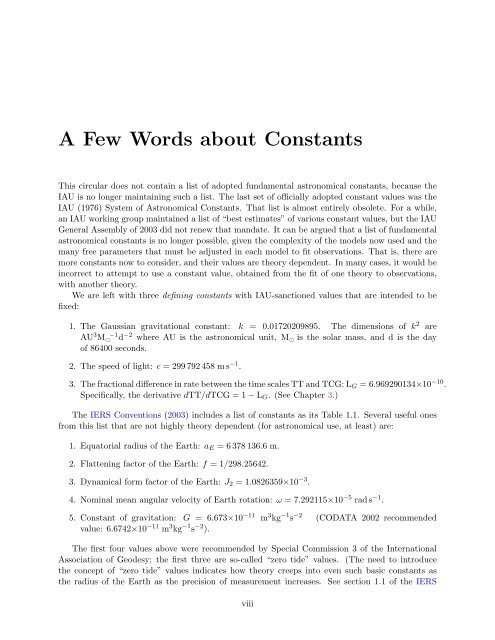USNO Circular 179 - U.S. Naval Observatory
USNO Circular 179 - U.S. Naval Observatory
USNO Circular 179 - U.S. Naval Observatory
You also want an ePaper? Increase the reach of your titles
YUMPU automatically turns print PDFs into web optimized ePapers that Google loves.
A Few Words about Constants<br />
This circular does not contain a list of adopted fundamental astronomical constants, because the<br />
IAU is no longer maintaining such a list. The last set of officially adopted constant values was the<br />
IAU (1976) System of Astronomical Constants. That list is almost entirely obsolete. For a while,<br />
an IAU working group maintained a list of “best estimates” of various constant values, but the IAU<br />
General Assembly of 2003 did not renew that mandate. It can be argued that a list of fundamental<br />
astronomical constants is no longer possible, given the complexity of the models now used and the<br />
many free parameters that must be adjusted in each model to fit observations. That is, there are<br />
more constants now to consider, and their values are theory dependent. In many cases, it would be<br />
incorrect to attempt to use a constant value, obtained from the fit of one theory to observations,<br />
with another theory.<br />
We are left with three defining constants with IAU-sanctioned values that are intended to be<br />
fixed:<br />
1. The Gaussian gravitational constant: k = 0.01720209895. The dimensions of k2 are<br />
AU3M −1<br />
○· d−2 where AU is the astronomical unit, M○· is the solar mass, and d is the day<br />
of 86400 seconds.<br />
2. The speed of light: c = 299 792 458 m s −1 .<br />
3. The fractional difference in rate between the time scales TT and TCG: LG = 6.969290134×10 −10 .<br />
Specifically, the derivative dTT/dTCG = 1 − LG. (See Chapter 3.)<br />
The IERS Conventions (2003) includes a list of constants as its Table 1.1. Several useful ones<br />
from this list that are not highly theory dependent (for astronomical use, at least) are:<br />
1. Equatorial radius of the Earth: aE = 6 378 136.6 m.<br />
2. Flattening factor of the Earth: f = 1/298.25642.<br />
3. Dynamical form factor of the Earth: J2 = 1.0826359×10 −3 .<br />
4. Nominal mean angular velocity of Earth rotation: ω = 7.292115×10 −5 rad s −1 .<br />
5. Constant of gravitation: G = 6.673×10 −11 m 3 kg −1 s −2 (CODATA 2002 recommended<br />
value: 6.6742×10 −11 m 3 kg −1 s −2 ).<br />
The first four values above were recommended by Special Commission 3 of the International<br />
Association of Geodesy; the first three are so-called “zero tide” values. (The need to introduce<br />
the concept of “zero tide” values indicates how theory creeps into even such basic constants as<br />
the radius of the Earth as the precision of measurement increases. See section 1.1 of the IERS<br />
viii


